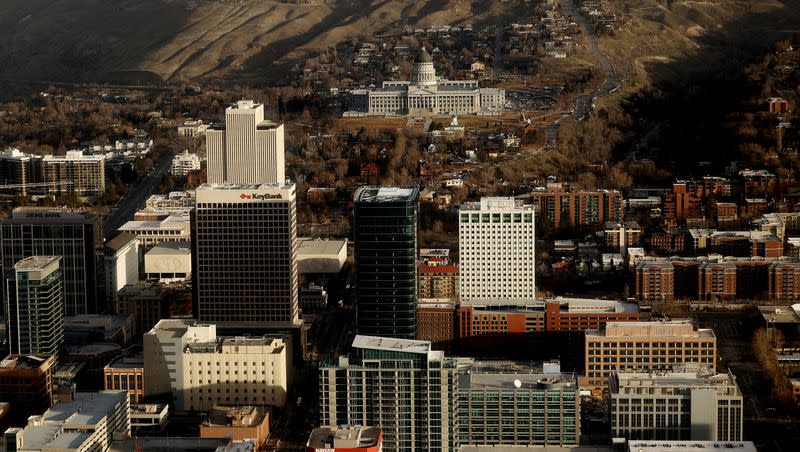Analysis: Why people are fleeing blue states for red ones, and what Utah shows us

- Oops!Something went wrong.Please try again later.
Domestic migration has led to shifts in population as red states grow and blue states shrink, which could lead to a reshaping of American politics.
There are several competing theories to explain why this is happening. As analysts and elected officials on both sides of the aisle debate the potential ramifications of this shift, Utah may have already come up with a solution.
The Beehive State has a conservative majority, but its economic success, opportunities for entrepreneurship and pragmatic approach to policy means it has a different approach to policy than other states across the U.S.
A recent U.S. Census Bureau report shows 26 states benefited from net domestic migration in 2022. Florida, Texas and North and South Carolina were the states with the greatest population gains due to migration, each of them states where the GOP holds significant say over state politics.
The states that suffered from the largest net domestic outmigration were blue states like California, New York and Illinois, all Democratic strongholds. Last year’s numbers continue a similar pattern that started before the COVID-19 pandemic in 2020, but they’ve accelerated.
DeSantis’ claim
One of the popular theories for the shift comes from Florida Gov. Ron DeSantis, and others like him.
DeSantis told the Utah GOP last month he believes this is happening because of his less stringent approach to pandemic lockdowns compared to blue states like New York or California.
Some blue states shut down their local businesses and schools while Florida “refused to follow guidelines from (former chief medical adviser to the president, Dr. Anthony) Fauci,” he said. “We in Florida stood as a refuge of sanity. ... We refused to let our state descend into some type of Fauci-dystopia where people’s livelihoods were destroyed and freedom curtailed.”

Related
DeSantis is expected to announce a campaign for president soon, and he has repeatedly touted his nearly 20-point gubernatorial reelection win last November as proof that his Republican policies are what voters want.
Brooks’ hypothesis
His vote-with-your-feet hypothesis is one possible explantation for the shift, but New York Times columnist David Brooks recently noted that this trend has been happening in fits and spurts for well over a decade now.
“Between 2010 and 2020, the fastest-growing states were mostly red — places like Texas, Georgia, Florida, Tennessee and South Carolina. During the pandemic, that trend accelerated, and once again, most of the big population-gaining states are governed by Republicans,” Brooks said.
Utah was the fastest-growing state in the previous decade, increasing by 18.4%, followed by Idaho, Texas and North Dakota. Texas and Florida led the nation with the largest numerical population increases.
Blue dots in a red field
Brooks suggests pro-business polices are the prime mover of American workers and their families. An American Enterprise Institute study pitting the top 10 destination states with the top 10 states people are leaving from seems to provide some evidence for his state government management theory.
Lower taxes, fewer home building regulations and lower utility bills are just some of the factors that entice businesses and workers to relocate, he said.
Harvard economist Edward Glaeser’s studies show the nation’s best performing cities were typically blue cities in red states — places like Austin, Texas; Miami, Florida; or Raleigh, North Carolina.
For that reason, Brooks suggests that the winning formula sought for by voters might be a mix of conservative and liberal policies.
“If you look at these success stories, you see they are actually the product of a red-blue mash-up,” Brooks said. “Republicans at the state level provide the general business climate, but Democrats at the local level influence the schools, provide many social services and create a civic atmosphere that welcomes diversity and attracts highly educated workers.”
‘Don’t California my Utah/Idaho’
Red states may make the most business-sense but it seems less likely that Californians and New Yorkers would ditch their assumed socially progressive values. In places like Utah and Idaho, conservatives have wondered — and worried — that their new blue state neighbors could turn their red states purple.
But The Atlantic’s Jerusalem Demsas wrote in February that a political shift in America’s macro-political dynamic is doubtful.
“Although some predict that liberals moving to red states could moderate our nation’s politics, that seems unlikely given states’ tendency to preempt local policy, she said.
There’s also some anecdotal evidence that, so far, the Californians moving from the progressive West Coast states lean politically right and fit in with Utah and Idaho’s conservative politics.
This phenomenon was abundantly present last year in the interviews I conducted with supporters of then-attorney general candidate for Idaho, Raúl Labrador. At a campaign event, one born-and-raised San Franciscan told me he fled to the Gem State because his home city adopted “liberal policies” that made it unrecognizable.
“Many of us (from California) are Paul Reveres trying to warn the GOP in Idaho of what’s coming,” he said.
Which theory is right?
Time will tell whether the Brooks or DeSantis prognostication is correct. Are Americans siloing into self-selected jurisdictions that fit their ideology, or are workers simply following market forces and the relocation of business hubs?
Really, both could be right: DeSantis in his short-term evaluation and Brooks in identifying the most powerful drivers of change.
Politicians are often — for lack of a better term — short-sighted. Frequent elections incentivize them to worry about the here and now. DeSantis is probably right that the newly arrived Floridians from New York and other places made the jump for reasons related to ideology, and to hope that government will let them live their lives without disruption.
Last week, news broke that Democratic New York Gov. Kathy Hochul is planning to ban natural gas hookups for most new construction. The consequences of the new building regulations could be higher energy prices for tenants. Those who left the Empire State are likely patting themselves on the back, and many more may pack their bags and hit the highway.
But political winds and public sentiment are known to shift from election to election; so as Brooks has noted, recent policies don’t fully explain the new population shifts in the country.
Long-term, it appears Americans are following the money. Businesses and markets like stability and Republican states are providing that environment, which also explains Utah’s success.
Utah’s secret-sauce
Yesterday, the U.S. News and World Report awarded the state of Utah the title of “best state,” primarily for its “economy and fiscal stability.”
Counter to modern conventional wisdom, Utah Republican Gov. Spencer Cox said his goals for the state aren’t entirely economically driven. He said Utah’s objectives include preserving the state’s family-oriented culture.
“I don’t want Silicon Slopes to become like Silicon Valley,” Cox told an audience on Tuesday, referring to Utah’s burgeoning tech industry. “If you want to work 23 hours a day and never see your family, and change the world but not have a great life, go to San Francisco. There’s a place for you there.”
Cox emphasized the lifestyle focus that Utahns prioritize and that the Republican government attempts to reflect. “We have something very special here,” he continued, “and that special thing is we care about our families and we care about our neighbors. And that’s what makes Utah different.”
America’s ongoing population shifts are not likely to invite a cease-fire between the country’s dueling political parties, but perhaps Utah’s success in balancing economic growth with voters’ quality of life priorities can be a model for others to emulate.

